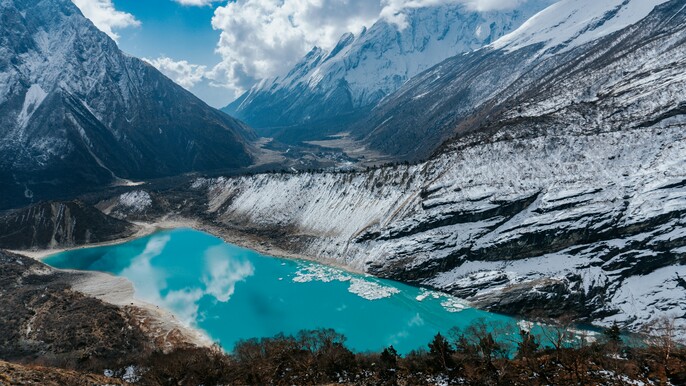Manaslu’s Hidden Gem: Tsum Valley Adventure

Description
The 15-day Tsum Valley Trekking is in the Manaslu region of Nepal. It perfectly represents the surrounding atmosphere of the area. Mount Manaslu (8163 meters) resides in the western territory between Langtang and the Annapurna Range. The Budhi Gandaki River slides from the Manaslu, cutting colossal hills in lower areas. These raging rivers create a plain basin as a flatland between the high hills. Tsum Valley, known as the “Veiled Basin of Manaslu region,” is iconic. This is considered a remote and less crowded Trek in the Himalayas for 2024/2025.
Tsum Valley is nestled over in the remotest stretch of the Gorkha district. Furthermore, Treks to Tsum Valley is still secluded. Your adventure trekking begins from Kathmandu. It takes scenic road travel via Prithvi Highway until Dhading Besi and follows northbound.
The pathway will take you until Maccha-Khola. Herein, Maccha-Khola is a small village in Gorkha district, the initial point of the Trek. The path toward Tum Valley follows the Budhi Gandaki River, raging around the year.
The trekking journey to Tsum Valley follows through the riverside hamlets of Lapubesii, Khorlabesii, Jagaat, Salleri, and Ekle Bhatti before reaching Lokpaa village. Jagat village acts as the entry and exit point for the restricted area in this Trek.
Lokpaa Hamlet is the divergent point between the Manaslu Circuit Trek and the Tsum Valley Trek. Furthermore, the trekking path from here heads eastward, making gradual ascents. Lokpa village is a confluence point for the Budhi Gandaki River that originates in Manaslu.
The other watercourse is the Syar River, which forms from Tsum Valley. Trekkers follow along the pathway trailing through the basin of the Syar River. Then follows a series of Buddhist villages while trekking in Tsum Valley.
These inhabitants of Tsum Valley have long been Tibet trading routes of northerners. Some prominent monasteries of Tsum Valley are Rachenn Monastery, Gumbaa Lungdang, Milarepaa Piren Phu, and the oldest monastery of Tsum Valley, Mu Gompaa.
The pathway to Tsum Valley envisions a series of Sherpa, Gurung, and Thakali villages. Tumje is a crossroad point for the Ganesh Himal Base Camp Trek. Followingly, we traverse via Chhule, Nile, and Choo Syong before reaching Mu Gompaa.
Mu Gompaa is the best attraction in this basin area. Located amidst a vast cliff, this monastery is the oldest of all. The intricate carvings and artistic architecture from centuries before make Mu Gompa irresistible.
Daily Hiking Distance
- Maccha Khola to Jagat: 13-15 km (8-9 miles)
- Jagat to Lokpa: 12-14 km (7-8 miles)
- Lokpa to Chumling: 11-13 km (6-8 miles)
- Chumling to Rachen Gumba: 10-11 km (6 miles)
- Rachen Gumba to Mu Gumba: 10-12 km (6-7 miles)
- Mu Gumba to Rachen Gumba: 10-12 km (6-7 miles)
- Rachen Gumba to Gumba Lungdang: 7-9 km (4-6 miles)
- Gumba Lungdang to Ripchet: 8-10 km (5-6 miles)
- Ripchet to Philim: 10-12 km (6-7 miles)
- Philim to Khorla Besi: 7-9 km (4-6 miles)
- Khorla Besi to Soti Khola: 13-15 km (8-9 miles)
Included
- Airport picks up and drops by car/van/bus.
- 2 night accommodation in Kathmandu on BB basis.
- During the trekking, three meals a day (Breakfast, Lunch, and Dinner).
- Highly experienced, helpful, and friendly Trekking and Tour Guide
- Manaslu Conservation Entry Permits.
- Restricted Area Permit.
- TIMS Permits.
- Nepal Government taxes
- Ground transportation by bus
- Per person, one trekking map.
- Sleeping Bag (Options)
- Down Jacket (Options)
Excluded
- Cold and Hot drinks
- Hard and Soft drinks.
- Hot Shower During the trek.
- Meals in Kathmandu.
- Donation & Tips.
- City sightseeing entry fees.
- The rest of everyday expenditure which is not mentioned in the price includes.
Know before you go
When embarking on the 15 Days Tsum Valley Trek, travelers should pack wisely to ensure a comfortable and safe journey. Here’s a checklist of essential items:
- Clothing:Lightweight, moisture-wicking base layers
Insulating layers (fleece or down jacket)
Waterproof and windproof outer shell (jacket and pants)
Comfortable trekking pants (convertible to shorts)
Warm hat, gloves, and buff/scarf
Sturdy hiking boots and extra socks - Footwear and Accessories:Well-fitting hiking boots with good ankle support
Gaiters (to keep snow and debris out of boots)
Sunglasses with UV protection
Sun hat or cap
Trekking poles (optional but helpful) - Sleeping Gear:Warm sleeping bag (rated for sub-zero temperatures)
Lightweight sleeping pad or mat - Personal Items:Passport, permits, and travel insurance documents
Personal medications and first aid kit
Toiletries (toothbrush, toothpaste, wet wipes, etc.)
Headlamp or flashlight with spare batteries
Water purification tablets or filter - Miscellaneous:Daypack (for daily essentials)
Snacks (energy bars, nuts, dried fruits)
Reusable water bottle or hydration system
Camera or smartphone for capturing memories
Cash (local currency) for small purchases
Remember to pack light but adequately, as you’ll be carrying your own gear during the trek. Enjoy the stunning landscapes and cultural experiences along the way









